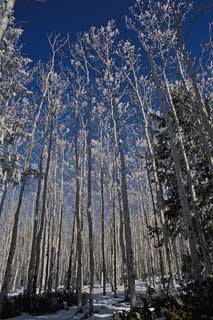
This shot shows one angle of shooting through the canopy, along with conditions being just right for hoarfrost to appear. Hoarfrost, actually ice crystals, forms on cold clear nights when radiation losses into the open skies cause objects to become colder than the surrounding air. Again, a nice blue sky to contrast with this scene can enhance the feel of the shot.
No matter what the season, plenty of opportunities await when you’re planning to use trees as the primary point of interest in a photograph. If you use the light and/or weather to their best advantage, you can greatly enhance your images. However, for many photographers, fall is their favorite time to make trees the strength of their composition. The vivid and various colors of the leaves provide plenty of angles from which to capture their beauty, detail, and impressiveness.
Depending on the density of the aspen trees in a given area, a popular shot requires that the photographer lie on the ground and shoot straight up through the canopy. The golden color of aspens in fall is better when the light is at an angle or even backlit rather than direct front lighting. Another way to achieve a similar shot is to use a cable release and set the camera on the ground before you back away to shoot. While you won’t see the exact composition you’re capturing, that positioning allows for a steady camera that can be set to maximum depth-of-field. If you leave the camera on the ground and move it slightly between shots, the results will give you an array of compositions to examine to locate one that really works for you.
In many places where fall colors are prominent, an early snow isn’t an unheard-of happening. Combining the two of these special conditions can make some very dramatic images. Showcasing a couple types of trees with snow on their differently colored leaves or on the ground around them creates very good contrast. Intimate landscapes work best. Instead of looking at the whole scene that presents itself, try to isolate just a few trees or some details in the trees to accentuate the multiple colors, textures, and patterns. While exposures for most fall color shots is pretty straightforward, a little adjustment of compensation on the plus side by +1/3 or +2/3 could be called for to balance out the white of the snow.
If you arrive first thing in the morning after an overnight snow, then you have a change of catching snow clinging to the branches of the trees, creating a strong graphic image of the lines of the branches themselves and the snow lying on them working together. While including some of the fall color is helpful for a shot such as this, it’s not imperative to include it. Even if there’s just a subtle hint of color in the background, it can add to the feel and mood of the image.
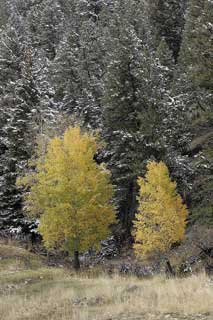
Copyright © Andy Long
Just a little snow highlights the mix of two tree types.
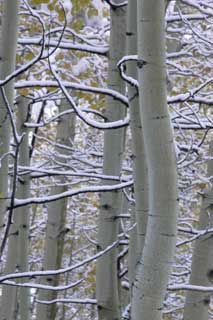
Copyright © Andy Long
A hint of color shows off an early season snow.
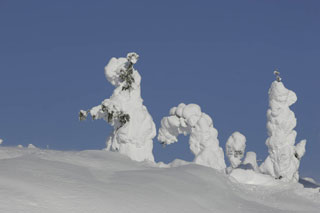
Copyright © Andy Long
Let you imagination run wild with the shapes created by a heavy blanket of snow.
More snow adds another dimension to the possibilities. In the dead of winter when there’s lots of snow on the ground, a solitary tree or a small group of trees standing in the vastness of snow creates a feeling of isolation in the composition. Also in winter, when the leaves have fallen off the deciduous trees, there is plenty of detail in the limbs and branches that can be highlighted.
In some places in winter the conditions are so extreme that large amounts of snow pile up on trees, creating very unique shapes. Some may even look like creatures from another world. If the weather cooperates and provides a crisp blue sky as a backdrop, then the contrast between a snow-covered tree and the sky can be very dramatic. Here, the trees might not look like trees typically do–with limbs, branches and leaves, but they will give enough of a hint that people will know what they are.
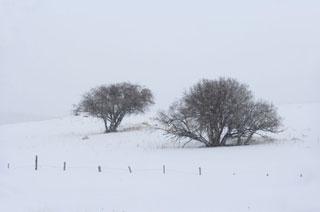
Copyright © Andy Long
Take time to seek out all the possibilities of the subject.
When you’ve selected trees as your main subject, take time to explore all your opportunities. Since your subjects have no choice but to remain still, you can change positions to achieve a variety of completely different shots of the same “model.” The three images here show how moving around a little bit, incorporating another object, and differing your placement can make multiple interesting shots.
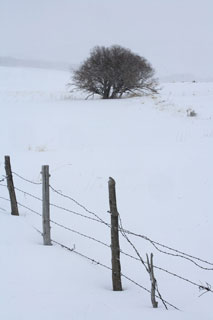
Copyright © Andy Long
Stacking the trees one behind the other blends them together.
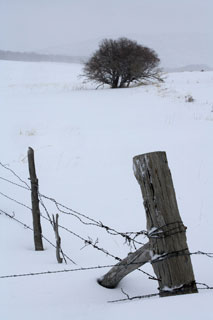
Copyright © Andy Long
The fence adds another element to the series.
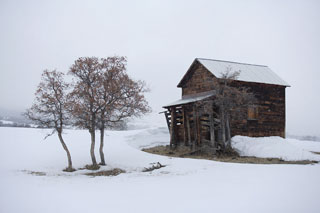
Copyright © Andy Long
When having two strong subjects, keep the spacing simple for the viewer.
A strong tree can add balance or increase the impact of other winter settings, as well. One situated near an old cabin can bring the scene to life. The key advice to keep in mind when you’re setting up a shot with two such subjects is to have space between the two and not to have part of the tree overlapping the structure, if at all possible. Leave enough space between the two so there isn’t a feeling of being cramped–but not too much space. If you insert too much space, when the viewer looks at the shot his eyes won’t bounce back and forth between subjects, and he won’t experience the full intention of the image.
Another potential way to look at trees in snow is by emphasizing their shadows on the ground on a sunny day. In summer, the ground is cluttered with vegetation, but a layer of snow in winter creates a nice palette on which shadows give a feeling of depth and strong graphic appeal. Including one or more trees in the shot provides perspective, although adding entire trees can take the viewer away from the intended strength of the shadows.
One weather condition that can happen at different times of the year is fog. Photographing trees in a thick fog isolates them from the surroundings, and the mood it brings out can be very relaxing. A light fog in which surrounding objects can still be seen can also offer a good shooting condition. One of Ansel Adams’ top prints is of an oak tree shrouded in fog with a low sun coming through in the background. The thicker the fog for this type of shot, the better, as it helps obscure whatever else is in the viewfinder and puts all the emphasis on the main subject.
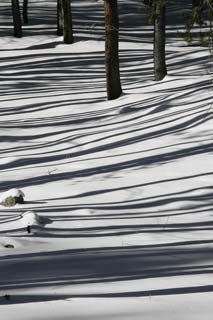
Copyright © Andy Long
Shadows of trees add a strong graphic element to this different look at trees.
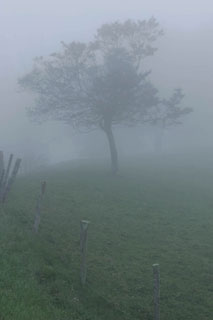
Copyright © Andy Long
Fog helps isolate the tree from the background and create mood.
Typically, photographers are advised to overexpose fog shots, as fog tends to be lighter in color than a clear day. While this is true, sometimes you might want to portray a different effect. This is where bracketing comes in. Shoot several images on the plus side, but don’t think underexposing is out of the question because this is where it can deepen the mood. (While the LCD might not provide the best view of your shot, the histogram can be useful in showing if the highlights are blown out.)
At any time of year, soft morning or evening light can bring out the texture of some trees. Coming in tight to emphasize the patterns and textures is another way to try to build a collection of tree shots. Storm clouds in the background can create a dramatic look at these ever changing parts of nature. In areas where heavy wind is common, you can detect the prevailing wind direction because any trees that are not in a large group have a definite lean to them that might give you interesting shots. Whether as a silhouette against a nice background, colorful reflections in water, or buried in snow, trees offer endless possibilities and challenges to you as the photographer to bring their images to life.
by Andy Long

Leave a Reply